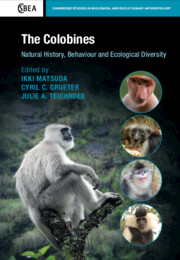35 results
Copyright page
-
- Book:
- The Colobines
- Published online:
- 08 February 2022
- Print publication:
- 24 February 2022, pp vi-vi
-
- Chapter
- Export citation
22 - Directions for Future Research
-
-
- Book:
- The Colobines
- Published online:
- 08 February 2022
- Print publication:
- 24 February 2022, pp 394-398
-
- Chapter
- Export citation
Contents
-
- Book:
- The Colobines
- Published online:
- 08 February 2022
- Print publication:
- 24 February 2022, pp vii-viii
-
- Chapter
- Export citation
20 - State of Asian Colobines and Their Conservation Needs
-
-
- Book:
- The Colobines
- Published online:
- 08 February 2022
- Print publication:
- 24 February 2022, pp 324-341
-
- Chapter
- Export citation
Contributors
-
- Book:
- The Colobines
- Published online:
- 08 February 2022
- Print publication:
- 24 February 2022, pp ix-xii
-
- Chapter
- Export citation
References
-
- Book:
- The Colobines
- Published online:
- 08 February 2022
- Print publication:
- 24 February 2022, pp 399-496
-
- Chapter
- Export citation
1 - General Introduction
-
-
- Book:
- The Colobines
- Published online:
- 08 February 2022
- Print publication:
- 24 February 2022, pp 1-2
-
- Chapter
- Export citation
12 - Ecology and Behaviour of Odd-Nosed Colobines
-
-
- Book:
- The Colobines
- Published online:
- 08 February 2022
- Print publication:
- 24 February 2022, pp 156-185
-
- Chapter
- Export citation
Foreword
-
- Book:
- The Colobines
- Published online:
- 08 February 2022
- Print publication:
- 24 February 2022, pp xiii-xv
-
- Chapter
- Export citation
Index
-
- Book:
- The Colobines
- Published online:
- 08 February 2022
- Print publication:
- 24 February 2022, pp 497-508
-
- Chapter
- Export citation
6 - Morphology and Physiology of Colobine Digestive Tracts
-
-
- Book:
- The Colobines
- Published online:
- 08 February 2022
- Print publication:
- 24 February 2022, pp 64-77
-
- Chapter
- Export citation
Acknowledgements
-
- Book:
- The Colobines
- Published online:
- 08 February 2022
- Print publication:
- 24 February 2022, pp xvi-xvi
-
- Chapter
- Export citation

The Colobines
- Natural History, Behaviour and Ecological Diversity
-
- Published online:
- 08 February 2022
- Print publication:
- 24 February 2022
10 - Proboscis Monkey Conservation
- from Part II - Habitat Alteration in the Anthropocene
-
-
- Book:
- Primate Research and Conservation in the Anthropocene
- Published online:
- 25 January 2019
- Print publication:
- 31 January 2019, pp 182-196
-
- Chapter
- Export citation
Part IV - Swamp Primates
-
- Book:
- Primates in Flooded Habitats
- Published online:
- 24 December 2018
- Print publication:
- 03 January 2019, pp 152-215
-
- Chapter
- Export citation
Chapter 6 - Survey and Study Methods for Flooded Habitat Primatology
- from Part I - Introduction
-
-
- Book:
- Primates in Flooded Habitats
- Published online:
- 24 December 2018
- Print publication:
- 03 January 2019, pp 33-43
-
- Chapter
- Export citation
Chapter 4 - Comparison of Plant Diversity and Phenology of Riverine and Mangrove Forests with Those of the Dryland Forest in Sabah, Borneo, Malaysia
- from Part I - Introduction
-
-
- Book:
- Primates in Flooded Habitats
- Published online:
- 24 December 2018
- Print publication:
- 03 January 2019, pp 15-28
-
- Chapter
- Export citation
Chapter 2 - Flooded and Riparian Habitats in the Tropics: Community Definitions and Ecological Summaries
- from Part I - Introduction
-
-
- Book:
- Primates in Flooded Habitats
- Published online:
- 24 December 2018
- Print publication:
- 03 January 2019, pp 2-9
-
- Chapter
- Export citation
Copyright page
-
- Book:
- Primates in Flooded Habitats
- Published online:
- 24 December 2018
- Print publication:
- 03 January 2019, pp iv-iv
-
- Chapter
- Export citation
References
-
- Book:
- Primates in Flooded Habitats
- Published online:
- 24 December 2018
- Print publication:
- 03 January 2019, pp 375-442
-
- Chapter
- Export citation



